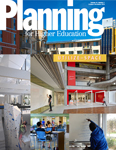- Planning Types
Planning Types
Focus Areas
-
A framework that helps you develop more effective planning processes.
- Challenges
Challenges
Discussions and resources around the unresolved pain points affecting planning in higher education—both emergent and ongoing.
Common Challenges
- Learning Resources
Learning Resources
Featured Formats
Popular Topics
- Conferences & Programs
Conferences & Programs
Upcoming Events
- Community
Community
The SCUP community opens a whole world of integrated planning resources, connections, and expertise.
Get Connected
Give Back
-
Access a world of integrated planning resources, connections, and expertise-become a member!
- Planning Types
Planning Types
Focus Areas
-
A framework that helps you develop more effective planning processes.
- Challenges
Challenges
Discussions and resources around the unresolved pain points affecting planning in higher education—both emergent and ongoing.
Common Challenges
- Learning Resources
Learning Resources
Featured Formats
Popular Topics
- Conferences & Programs
Conferences & Programs
Upcoming Events
- Community
Community
The SCUP community opens a whole world of integrated planning resources, connections, and expertise.
Get Connected
Give Back
-
Access a world of integrated planning resources, connections, and expertise-become a member!
 Planning for Higher Education Journal
Planning for Higher Education JournalPositioning Liberal Arts Campuses to Participate in Regional Economic Development
A Primer From Volume 43 Number 1 | October–December 2014By Peter M. Fairweather, Kenneth A. GiffordPlanning Types: Resource Planning
From Volume 43 Number 1 | October–December 2014By Peter M. Fairweather, Kenneth A. GiffordPlanning Types: Resource PlanningUntil very recently, the idea of higher education as an economic catalyst has focused almost exclusively on land-grant colleges and research universities. In little more than a decade, the perceived economic development role of higher education has expanded from a narrow field of large elite research institutions to include small liberal arts colleges, many of which traditionally saw their role as a refuge from economic forces rather than as an active creator of them. Liberal arts colleges, and, in particular, public liberal arts colleges, now confront an entirely new set of expectations from the regions in which they are located.
Almost every college has some kind of catalytic role to play in its regional economy. However, in order to be accepted as an effective partner, a college’s economic development responses must be perceived as credible by the larger community, and in order to sustain campus support, they must be seen to add real value to the institution itself. This article provides an overview of the key issues that a liberal arts campus must address as it prepares to enter the economic development arena.MEMBERS ONLY
Attention Members: Log in to access this item.Not a member? Join now to access this article and all journal articles for free.



